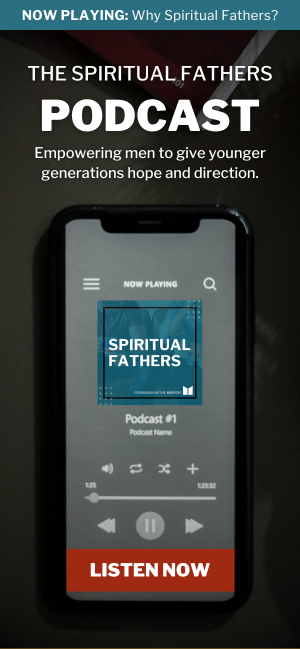Overcoming a Skyscraper Ministry
We’ve been looking at capturing momentum over the last several posts and how many churches struggle with a roller-coaster men’s ministry. They hold events and programs, men get excited, but then lose all the momentum they’ve built as men go back to their normal routine. So, in order to get off the roller coaster, we talked about the importance of having a “next step mindset” and avoiding two common traps many churches fall into in men’s ministry. In this post, we’ll discuss how to help men take that next step in their spiritual journey and capture the momentum we’ve created.
Imagine you are visiting New York City and a friend takes you to the top of a skyscraper. As you look over the beautiful city, he points to a building across the street and tells you about the wonderful restaurant on the top floor. “Why don’t we just jump over there right now and have some lunch?” You’d look across at the building, then down at the street, and conclude that your friend was crazy. It’s ridiculous to think you could jump forty-five feet to another skyscraper.
Often the ministries and programs of our churches are like skyscrapers in New York City. Each of them exists without clear connection to other church programs. A person is involved in a Sunday School class and/or the praise team and/or a short-term mission trip, but there are no real connections between the initiatives. So getting a man who attends worship to join a couple’s small group or a men’s bible study is like asking him to jump from one skyscraper to another—it seems impossible.
The ironic thing is this: Some people are willing to make the jump. There are always the committed few who will take a leap of faith and dive head first into a new opportunity. In fact, enough people make these jumps in most churches to prevent us from seeing how poorly we have integrated a believable process of discipleship. But the vast majority of people will stay exactly where they are unless we build bridges to connect the opportunities together and make it obvious how to move from one step to the next. That’s what it means to capture momentum.
Choose Good “Second Gear” Material
Look for “cookies on the bottom shelf” materials that raise significant issues and deal with them Biblically. Men will make a one-time, short-term commitment to something that seems “doable.”
The case study in the box below illustrates two other common mistakes we often make. Can you find them?
One church shared that they seemed to have reached a “ceiling” of sorts with the number of men who would engage in their small groups. When we asked them what they were doing to recruit men, their strategy seemed pretty sound, at first.
They would have men’s events in the church that had a broad appeal to the men. Every event was extremely well-attended. At each event, they would offer an opportunity to join in a group for ongoing study. They were using good, second gear material. They were only asking for a short-term commitment. Everything seemed fine.
Then we asked the question: How are you signing guys up for the small groups? “Simple,” they said. “We list all of the groups on a separate piece of paper in the back. Each group lists the name of the leader, when and where they are meeting, and how many spots they have available. So they find a group that’s convenient and they write down their name, then the leader follows up. But only a few guys who aren’t already in a small group or have been in one before ever sign up. And even those that do often don’t show up.”
Let Everyone Play on a Level Field
The first error is listing groups with the number of spots available. A man who looks at that quickly realizes he is walking into an established group. Who else is in the group? How long have they been meeting? He is obviously going to be the “new guy.”
If you ever switched schools growing up, you remember what lunch was like for the first week. Everybody already had “their” table. You didn’t really know how open they might be to a new kid sitting with them.
We might all be adults now, but that fear of rejection never goes away. Always start new groups for your follow-up.
Help Men Take The Next Step—On the Spot
Did you spot the second error? Don’t have guys write their names on a list and tell them you’ll “get back to them.” You want men to leave feeling like they’ve already made the commitment. So whatever your next step, always ask for an on-site commitment.
Here’s a proven method to get two-thirds of your men into follow-up small groups:
Hold an event that reaches a specific target group of men, like a Success That Matters event from Man in the Mirror. Promote the event with—say it with us now!—personal invitations. Before the event, recruit leaders who will commit to running a six-week follow-up group—about one leader for every 8-9 men you expect to attend the men’s event. (If two thirds of the men sign up, that will give you groups of five or six for each leader.)
At the beginning or middle of the event, announce that there is a “next step” for everyone after the event. Show them the material they will be using, and make sure they understand that it is a short-term commitment. This gives them time to absorb the idea.
We like to use the following illustration during a men’s event to explain the benefit of the follow-up groups:
“If you give me $100 now, I will give you $200 at the end of this seminar. How many of you would take me up on that offer?” Every hand usually goes up!
“Now, let me offer you a different deal. If you will give me $200 now, I will give you $1000 in six weeks. Double the investment of the first deal, but five times the return. How many of you would take that deal?” Usually someone stands up and jokingly starts to take out his wallet at this point.
“Well guys, this is exactly the deal I am offering you. If you will give me about 8 hours of time over the next day, I am going to give you a pretty good return on your investment. But if you will double that investment, and spend another eight hours over the next six weeks meeting with some other guys from this group to go over this study guide we’re giving you, you will get five times as much out of it as if you just listened to me alone.”
“The fact is that I can only give you information that will make you think during this seminar. If you really want to see how this will apply to your life, you need to spend some time exploring these issues with a few other guys who live in your world.”
Provide several sessions for small group discussion throughout the event. This helps model the follow-up groups and gets men talking to each other. We often hear of churches that had to break up the discussions to move to the next session.
About three quarters of the way through the event, instead of going into another small group discussion time, let your men know you will now be forming the groups for follow up. Have each leader stand, introduce himself, and share when and where his group will be meeting. “Hi, I’m Don Smith. My group is going to meet at the Denny’s on the corner of 5th and Main on Thursday mornings at 6:30 am.” And so on.
After all the leaders have introduced themselves, tell the men that for the next discussion time, you would like them to pick a group that they might be interested in continuing with after the event. Remind them it’s only a six-week commitment. Tell them that even if they don’t plan on attending a group afterwards, just to go ahead and pick one for the discussion time.
A Method To The Madness
At this point, all of the men in the room are staring at you, and you have to say, “OK, right now! Pick someone to sit with! Get going!” They’re men, remember? They will finally start moving, and before you know it each man will be sitting in a circle with some other men. It’s messy, and looks unorganized, but it works! The secret to this is that men are smart and will figure it out. You don’t have to micromanage the process. In fact, micromanaging will actually reduce your effectiveness.
Before they get into the discussion, the leaders pass around a sheet of paper to collect each man’s name, phone and e-mail. Then they confirm the time and location of their very first meeting—make it within the next seven days—and adjust it if necessary to meet the men’s needs. Then they briefly look at the material they will be using. We provide a simple sixteen-page workbook with Man in the Mirror events. If they have time, they’ll go into the discussion questions for the session that just ended.
Even a man who might have gone reluctantly to sit in a group will become somewhat invested in when and where they will meet, what they will talk about, and who will be there.
Does it work? In events where churches use this method just the way it’s described here, over two thirds of the men indicate that they have decided to join the follow-up groups. Perhaps even more exciting, the percentage of men who have never been in a small group before and choose to be in the follow-up groups is even higher.
The Big Idea: Don’t make men “leap” from one opportunity to the next. Build bridges that make it easy and intuitive for a man to move forward in his spiritual journey.
♦♦♦








